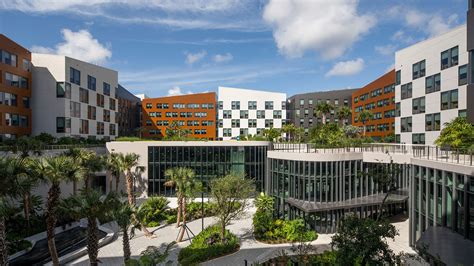As the academic landscape in Miami continues to flourish, so does the demand for quality student housing. With a plethora of options available, finding the perfect abode can be a daunting task. This comprehensive guide delves into the intricacies of student housing in Miami, providing insightful tips and expert advice to help students make informed decisions.

1. Explore Neighborhoods
Miami is a vibrant city with distinct neighborhoods that cater to the diverse needs of students. Here’s a brief overview:
South Beach: Known for its iconic beaches, bustling nightlife, and luxury apartments.
Coral Gables: A charming neighborhood with a historic downtown, tree-lined streets, and upscale student housing.
Little Havana: A vibrant Cuban enclave that offers affordable housing and a lively atmosphere.
Brickell: Miami’s financial district, featuring modern high-rises and nearby restaurants and shops.
Wynwood: An artsy district with colorful street art, trendy bars, and unique student housing options.
2. Consider Budget
Student housing in Miami can range from budget-friendly to luxury. The average monthly rent for a single bedroom apartment in popular areas is around $1,500-$2,500. Consider your budget and explore options such as shared apartments, roommate matching services, or on-campus housing.
3. Prioritize Amenities
Amenities play a crucial role in student housing. Look for options that offer essential features such as:
- In-unit laundry
- Secured access
- Study rooms
- Fitness centers
- Swimming pools
Consider amenities that align with your lifestyle and academic needs.
4. Seek Proximity to Campus
Location plays a vital role in choosing student housing. The closer you are to campus, the more convenient your daily commute will be. Research the distance from potential housing options to your university or college.
5. Explore Furnished Options
Furnished student housing can save you the hassle of purchasing furniture. It’s ideal if you’re new to Miami or on a tight budget. Inquire about the availability of furnished units and the cost of any additional fees.
6. Read Reviews and Ratings
Before signing a lease, take the time to read reviews and ratings of potential housing options. These insights from previous tenants can provide valuable information about the cleanliness, maintenance, and overall experience.
7. Consider Off-Campus Options
On-campus housing may not always be the best choice. Off-campus housing offers more flexibility, privacy, and often lower costs. Explore apartments, townhouses, or houses near your campus.
8. Utilize Student Housing Websites
Numerous websites specialize in student housing in Miami. These platforms allow you to search and compare available options based on your criteria. They often provide virtual tours, floor plans, and contact information for leasing agents.
9. Contact a Leasing Agent
Once you’ve narrowed down your search, contact a leasing agent to schedule a viewing. They can provide you with a personalized tour, answer your questions, and guide you through the application process.
10. Read the Lease Carefully
Before signing a lease, read the agreement thoroughly to understand your rights and responsibilities as a tenant. Pay attention to the lease term, rent amount, security deposit, and any additional fees.
Student Housing Options in Miami
Table 1: On-Campus Housing Options
| University | Address | Average Rent | Amenities |
|---|---|---|---|
| University of Miami | 1320 S Dixie Hwy, Coral Gables, FL 33146 | $1,600-$2,000 | Meal plans, fitness center, swimming pool |
| Florida International University | 11200 SW 8th St, Miami, FL 33199 | $1,400-$1,800 | In-unit laundry, study rooms, recreation center |
| Miami Dade College | 300 NE 2nd Ave, Miami, FL 33132 | $1,200-$1,600 | On-site parking, computer labs, tutoring center |
Table 2: Off-Campus Housing Options
| Neighborhood | Complex Name | Average Rent | Amenities |
|---|---|---|---|
| South Beach | The Mondrian South Beach | $2,500-$3,500 | Private balconies, rooftop pool, fitness center |
| Coral Gables | The Reva | $2,000-$2,800 | In-unit kitchens, study lounges, social events |
| Little Havana | Vintro | $1,600-$2,200 | Secured access, laundry facilities, pet-friendly |
| Brickell | Brickell City Centre | $3,000-$5,000 | Luxury apartments, shopping center, restaurants |
| Wynwood | The Wynwood | $1,800-$2,500 | Art-inspired decor, communal workspaces, outdoor courtyards |
Table 3: Shared Housing Options
| Website | Description | Fees |
|---|---|---|
| Roomster | Connects students with roommates for shared apartments | Free to join |
| Craigslist | A popular platform for posting shared housing ads | Variable fees |
| Facebook Marketplace | Allows users to post and browse listings for shared housing | Free |
Table 4: Budget-Friendly Options
| Option | Average Rent | Features |
|---|---|---|
| Studio Apartments | $1,200-$1,800 | Compact and efficient living space |
| Shared Housing | $800-$1,200 | Share rent and expenses with roommates |
| Subletting | Rent a room or apartment from a tenant who is temporarily away | Variable rates |
FAQs
1. When should I start looking for student housing in Miami?
It is advisable to start your search 6-9 months in advance, especially if you have specific location or amenity requirements.
2. What is the average cost of student housing in Miami?
The average monthly rent for a single bedroom apartment in popular areas ranges from $1,500-$2,500.
3. Can I sublet my student housing?
Yes, subletting is a common practice in Miami. However, it is crucial to check with your landlord for any restrictions or procedures.
4. Is it safe to live off-campus as a student in Miami?
Miami is generally considered a safe city, but it is essential to follow safety precautions and research the neighborhood before choosing an off-campus housing option.
5. How can I find a roommate to share housing costs?
Utilize online platforms such as Roomster or Craigslist to connect with potential roommates. Consider asking your friends, classmates, or fellow students for referrals.
6. What amenities are essential for student housing?
Essential amenities include in-unit laundry, secured access, study rooms, fitness centers, and swimming pools.
